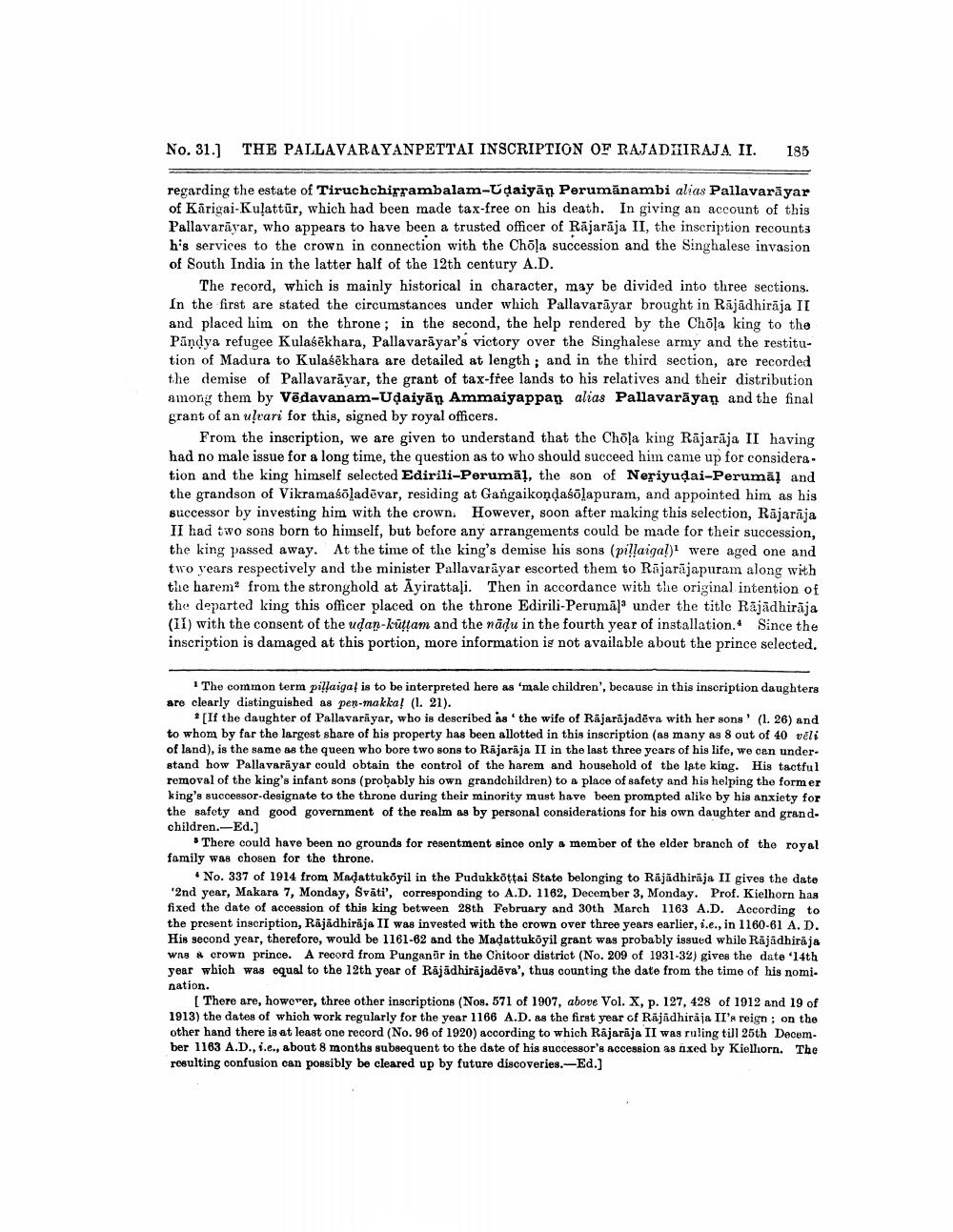________________
No. 31.) THE PALLAVARAYANPETTAI INSCRIPTION OF RAJADHIRAJA II.
185
regarding the estate of Tiruchchirrambalam-Udaiyān Perumānambi alias Pallavarāyar of Kärigai-Kulattūr, which had been made tax-free on his death. In giving an account of this Pallavarāyar, who appears to have been a trusted officer of Rājarāja II, the inscription recount: his services to the crown in connection with the Chõļa succession and the Singhalese invasion of South India in the latter half of the 12th century A.D.
The record, which is mainly historical in character, may be divided into three sections. In the first are stated the circumstances under which Pallavarāyar brought in Rājādhirāja II and placed him on the throne; in the second, the help rendered by the Chola king to the Pandya refugee Kulasēkhara, Pallavarāyar's victory over the Singhalese army and the restitution of Madura to Kulasēkhara are detailed at length; and in the third section, are recorded the demise of Pallavarāyar, the grant of tax-free lands to his relatives and their distribution among them by Vēdavanam-Udaiyāņ Ammaiyappan alias Pallavarāyan and the final grant of an uļvari for this, signed by royal officers.
From the inscription, we are given to understand that the Chola king Rājarāja II having had no male issue for a long time, the question as to who should succeed him came up for considera. tion and the king himself selected Edirili-Perumāļ, the son of Neriyudai-Perumāļ and the grandson of Vikramaçõladēvar, residing at Gangaikondaśālapuram, and appointed him as his successor by investing him with the crown. However, soon after making this selection, Rājarāja II had two sons born to himself, but before any arrangements could be made for their succession, the king passed away. At the time of the king's demise his sons (pillaigal) were aged one and two years respectively and the minister Pallavarāyar escorted them to Rajarajapuram along with the haremo from the stronghold at Ayirattali. Then in accordance with the original intention of the departed king this officer placed on the throne Edirili-Perumā) under the title Rājādhiraja (11) with the consent of the udan-küttam and the nādu in the fourth year of installation. Since the inscription is damaged at this portion, more information is not available about the prince selected.
1 The common term pillaigal is to be interpreted here as 'male children', because in this inscription daughters are clearly distinguished as pen-makka! (1. 21).
[If the daughter of Pallavarāyar, who is described as the wife of Rājarājadeva with her sons' (1.26) and to whom by far the largest share of his property has been allotted in this inscription (as many as 8 out of 40 vēli of land), is the same as the queen who bore two sons to Rajaraja II in the last three years of his life, we can under. stand how Pallavarayar could obtain the control of the harem and household of the late king. His tactful removal of the king's infant sons (probably his own grandchildren) to a place of safety and his helping the former king's successor-designate to the throne during their minority must have been prompted aliko by his anxiety for the safety and good government of the realm as by personal considerations for his own daughter and grandchildren.-Ed.
There could have been no grounds for resentment since only a member of the elder branch of the royal family was chosen for the throne.
No. 337 of 1914 from Madattuköyil in the Pudukkottai Stato belonging to Rajadhiraja II gives the date 2nd year, Makara 7, Monday, Svati', corresponding to A.D. 1162, December 3, Monday. Prof. Kielhorn has fixed the date of accession of this king between 28th February and 30th March 1163 A.D. According to the present inscription, Räjädhiraja II was invested with the crown over three years earlier, i.e., in 1160-61 A. D. His second year, therefore, would be 1161-62 and the Madattukoyil grant was probably issued while Rajadhiraja wng & crown prince. A record from Punganár in the Chitoor district (No. 209 of 1931-32) gives the date 14th year which was equal to the 12th year of Rājādhirajadēva', thus counting the date from the time of his nomi. nation.
There are, however, three other inscriptions (Nos. 571 of 1907, above Vol. X, p. 127, 428 of 1912 and 19 of 1913) the dates of which work regularly for the year 1166 A.D. as the first year of Rajadhiraja II's reign; on the other hand there is at least one record (No. 96 of 1920) according to which Rajaraja II was ruling till 25th December 1163 A.D., 1.c., about 8 months subsequent to the date of his successor's accession as axed by Kiellorn. The resulting confusion can possibly be cleared up by future discoveries.-Ed.)




